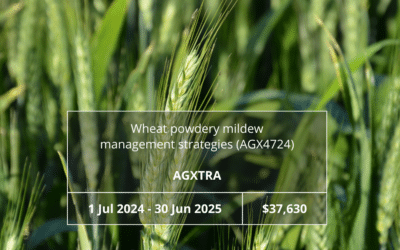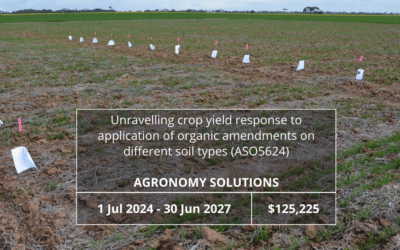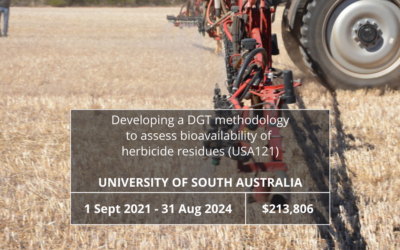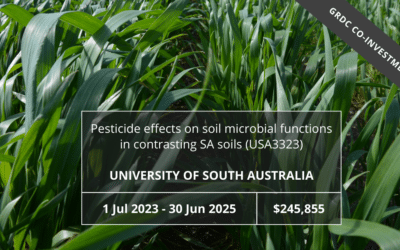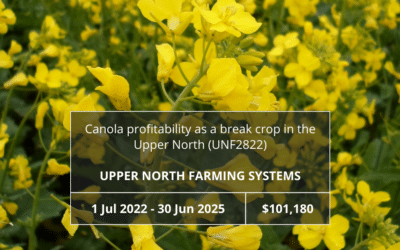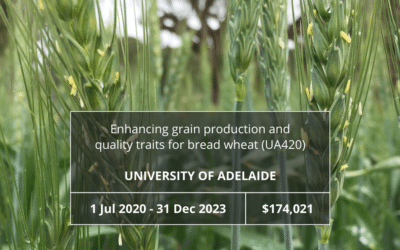This project aims to demonstrate to growers and agronomists the effectiveness of existing and emerging wheat powdery mildew (WPM) control options across varieties with diverse susceptibility ratings. It will also raise awareness of the importance of cultural considerations with regards to WPM management and an understanding of pathogen resistance to commonly used fungicides. This project provides an opportunity to extend existing knowledge generated through current SAGIT-funded WPM projects.
Latest Blogs - Current Projects
Unravelling crop yield response to application of organic amendments on different soil types (ASO5624)
Jul 11, 2024 | Current Projects
This project aims to assess the impact of organic amendments on soil condition and crop response on three contrasting soil types. Through this process, the aim is to provide growers with recommendations on ‘target soils’ where organic amendment applications can provide maximum benefit. Researchers will endeavour to define suitable frequency and application rates of organic amendments in combination with inorganic fertiliser.
Lead Agriculture Teacher (AGC6724)
Jul 11, 2024 | Current Projects
The Lead Ag Teacher role supports schools to more effectively teach and implement agriculture throughout their curriculum. The program, now in its third year, is delivered by AgC consultant Sue Pratt, an experienced agriculture teacher and past President of the Agricultural Teachers Association of SA (ATASA).
Ag Excellence Forum 2024 (AEX0524G)
Jul 11, 2024 | Current Projects
The Ag Ex Forum is held to bring together grower groups with industry, government, researchers and other expertise to address timely issues and an opportunity to extend networks. Forum 2024 will address the increasing pressure of sustainability trends and the role of technology.
Developing a DGT methodology to assess bioavailability of herbicide residues (USA121)
Nov 23, 2023 | Current Projects
A robust testing system for imidazolinone residues is to be developed using Diffusive Gradient in Thin-Films (DGT) technology. This tool will provide information on bioavailability of herbicide residues independent of soil type characteristics. The DGT tool will be validated in spiked soils, in a range of soil types and two water regimes. The DGT tool for glyphosate residue is also to be assessed.
Pesticide effects on soil microbial functions in contrasting SA soils (USA3323)
Nov 23, 2023 | Current Projects
The aim of this project is to understand how soil properties influence the effects of pesticides on soil health. The project team will assess six targeted pesticides in 10 contrasting South Australian broadacre cropping soils. This knowledge will deliver farmers essential information for identifying the best pesticide-soil combinations to maintain healthy soil microbial communities.
Canola profitability as a break crop in the Upper North (UNF2822)
Nov 23, 2023 | Current Projects
This project aims to explore if new canola technology allows it to be a more reliable and viable break crop option in the Upper North agricultural zone. The project will assess the profitability of different canola agronomy packages in local validation trials (GM vs open pollinated TT) against wheat over a three-year period.
Enhancing grain production and quality traits for bread wheat (UA420)
Nov 23, 2023 | Current Projects
Speed breeding to back cross F3-4 of wheat lines from AGT, Intergrain and LongReach Plant Breeders with lines that have potential to increase grain yields. These lines will be assessed for nitrogen use efficiency in glasshouse and field trials at Roseworthy, Mallala and Bordertown.
Latest Media
- New funding model, industry collaboration delivers $3.12m in grain research funding
- 101 questions about SA cropping soils you were never game to ask!
- 2025 Student Compendium
- Update on SAGIT-funded research into paraquat ahead of proposed restrictions
- Lead Ag Teacher continuing with cross-industry support

